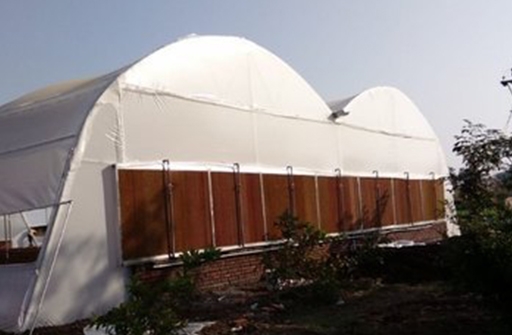Important implementation points about the greenhouse
Temperature is one of the important factors in the growth and quality of plants and greenhouse products. Greenhouses have a higher temperature than the outside air due to their enclosure and high lighting. In the summer season, the temperature inside the greenhouse rises to such an extent that sometimes it causes the entire crop to be destroyed. To solve this problem, you must use a standard cooling system. Considering that different plants need different temperatures, cooling systems can be used according to the required temperature, cultivation area, implementation cost and energy availability.

The positive pressure method is suitable for used greenhouses with many seams and dusty areas.
The negative pressure (suction) method is suitable for fully sealed (cape) and closed greenhouses.
Cellulose fan and pad
In the cooling system, cool air is injected into the hall by using the primary space of the greenhouse, where the fan and the pad are located at a short distance from each other, and this transfer can be done using the underground channels that have already been installed. In this system, with the evaporation process, the air that is forced by the fan from inside the cellulose pad or cover and... passes, performs the cooling action. In general, the biggest advantage of the positive pressure system is that when the cool air enters the hall, the hot air leaves the hall and no plant pathogens are allowed to enter through the openings of the greenhouse.
- The distance between the fan and cellulose pad should not be more than 40 meters.
- If the distance increases, use a fogger.
- In areas with a lot of dust, use a suitable soil filter.
- The water used should be kept as cool as possible.
- Keep the water tank in a cool place like underground.
Commercial greenhouses constitute an extensive industry worldwide.
Managers of large greenhouses know that a greenhouse is a food and flower production plant that requires constant attention and careful management.
One of the principles of greenhouse management is managing the weather in its environment.
Climate control is a major responsibility of greenhouse managers.
This includes providing optimal lighting, heating, ventilation, insulation and irrigation, as well as ensuring that it is clean and free of invasive pests, diseases and fungal contamination.
"The tactics include proper irrigation of the greenhouse, monitoring the general health of the plants, managing pests, controlling diseases, maintaining cleanliness and ensuring the proper functioning of the artificial environment."
Greenhouse business can flourish only if agricultural products are profitable.
This profitability includes all aspects of greenhouse management principles.
Effective greenhouse management includes energy efficiency and crop protection, which reduces costs.





